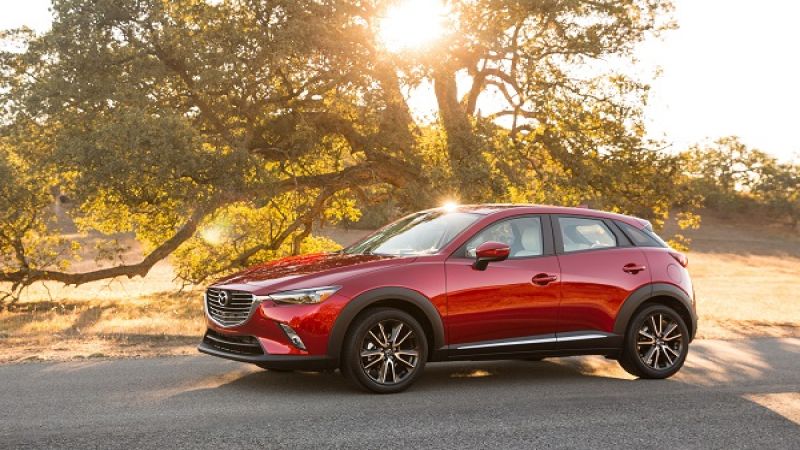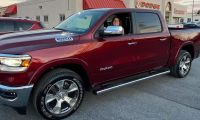Crossover mania has reached a fever pitch. Crossovers the size of the CR-V, RAV 4, and CX-5 are now a larger automotive segment than mid-size sedans like the Camry, Mazda6 and Accord. Next up are the sub-compact cute-‘utes. Both Mazda and Honda are out front leading this pack. Honda’s new HR-V is a fantastic car we had the chance to test recently. It has space in all the right places and it will be Honda’s next mega-hit. Mazda’s CX-3 is a real looker and as Car and Driver’s latest instrument test show, the clear leader in terms of performance in this new segment. Both cars have the same price points.
In Car and Driver’s* September print edition the magazine does a full comparison of the Jeep Renegade, Fiat 500X, Chevrolet Trax, Kia Soul, Honda HR-V, and Mazda CX-3. We won’t spoil the story for you by saying which cars finish in what rank, but we will compare the HR-V and CX-3’s instrument tests and explain why the CX-3 is so much quicker.
HR-V vs. CX-3 Performance Numbers
These are small city cars. One good gauge of performance is the 0-30 mph sprint. Here the CX-3 takes just 2.8 seconds. The HR-V 3.7 seconds. Next up is the 0-60 mph sprint. Again the CX-3 tops the HR-V with a respectable 8.1 seconds with the HR-V trailing at 9.3 seconds. Nobody will ever race these cars side by side to 100mph, but if they did the CX-3 would take 23.8 seconds and the HR-V would take 29.1 seconds. So, in terms of straight line acceleration the CX-3 is significantly quicker than the Honda HR-V.
When it comes to the slalom, the CX-3 is also faster with a speed of 42.1 mph compared to 39.7 mph for the HR-V. So the CX-3 can turn faster. The CX-3 also has a faster “top gear passing time” and top speed. So, if you are a fan of the Honda HR-V, you are now starting to think that there must be a fuel economy penalty for all this quickness the Mazda CX-3 is demonstrating. Nope. The CX-3’s tested fuel economy was 28 mpg; the HR-V’s was lower at 26 mpg (cue the sad music).
How CX-3 Beats HR-V
The Mazda CX-3 uses a transmission with gears. Despite the theoretical advantages constantly variable transmissions like the one in the HR-V should have, they are usually slower. The real trick though is torque. The CX-3 has 146 ft-lbs of torque and the Honda HR-V just 127 ft-lb. The CX-3 also has a smidge more power with 146 hp compared to the HR-V’s 141. We did not see the power and torque curves plotted, but clearly the Mazda CX-3 has it where it counts, down low in the rev band compared to the HR-V. The Mazda is also lighter by 174 pounds. Lighter, more powerful, better transmission. A win for the CX-3.
There is also one small detail we picked up on. The CX-3 uses slightly smaller tires. Smaller tires usually are also lighter. That means that the tires have less rotating mass to accelerate and thus, the car can be a bit quicker. What we like about this comparison of two excellent cars is that the Mazda edges the Honda by doing many small things. It was not just more powerful. The power is almost identical. The Mazda was just a tiny bit better in all the categories that add up to quickness and also fuel economy. That is what Skyactive means, and why Mazda talks about it so much.
Related Story: Honda HR-V and Mazda CX-3 have nearly identical prices
*Car and Driver September 2015 Pages 86-97













Comments
Thats all good and well if
Permalink
Thats all good and well if you like mazdas, which I dont. By the way, whats the damn hurry anyway?
Maybe my favorite comment
Permalink
In reply to Thats all good and well if by alan harper (not verified)
Maybe my favorite comment ever :)
The mazda's engine has direct
Permalink
The mazda's engine has direct injection, while the honda's doesn't. That's a much more relevant omission than patting yourselves on the back about noting an almost insignificant tire diameter difference. It explains the better torque curve and driveability, as well as most of the MPG.
The HR-V's engine is extremely dated, has been used in the civic virtually unchanged for 2 model cycles, and ilets down the design. It is reliable enough, but is a poor match for this car, especially in the AWD version.
Anyone buying the HRV is going to be awfully disappointed when the turbo 1.5 from the new civic engines are put in the car much sooner than later.
the hrv is part of hondas
Permalink
In reply to The mazda's engine has direct by dan (not verified)
the hrv is part of hondas earth dream which means it does have direct injection.
Well there's nothing like
Permalink
In reply to the hrv is part of hondas by bob (not verified)
Well there's nothing like someone who's sure of something, but is dead wrong anyway. That old 1.8l SOHC motor used in Civics since 2006 and now attempting to motivate the HR-V is PORT injection.
Just because Honda has a supply of Earth Dreams decals to stick on every engine they make, does not mean any given engine is direct injection. The Accord V6 is port injection, so is the 2.0l in the new base Civic.
There, now you know. And the HR-V did not do well in the C/D comparison test. The CX-3 won.
Sheer acceleration is the
Permalink
Sheer acceleration is the least significant factor in most peoples car purchase. The absolutely appalling space of the CX3 will elimate most crossover buyers.
Do not judge small CUV by
Permalink
In reply to Sheer acceleration is the by Shane Murphy (not verified)
Do not judge small CUV by space or lack of it , it is a smallest CUV class so judging it by more space is moronic... If you need more space buy slightly more expensive CX5 .
This new small CUV class is closer to a hatchback than a CUV/SUV ... When small driving dynamics should be superb and those are in CX3 but not in a porky Honda...
Mazda backs the 2016 CX-3
Permalink
Mazda backs the 2016 CX-3 with a three-year warranty, and it has an average predicted reliability rating.
Mazda's reliability is second
Permalink
In reply to Mazda backs the 2016 CX-3 by JAROD (not verified)
Mazda's reliability is second only to Lexus , it betters Toyota and specially CVT plagued Honda by a mile....
Mazda is not for every one , people who are car enthusiast and know how to appreciate driver oriented design and approach like them and value them....